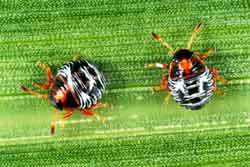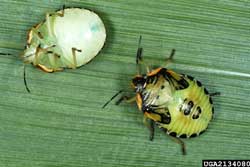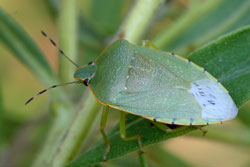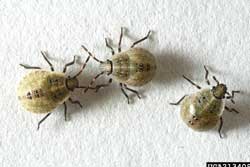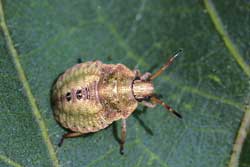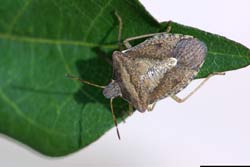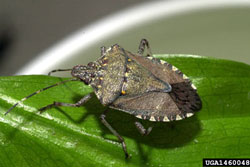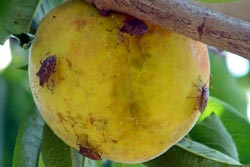Stink Bugs
Stink bugs feed on many plants, including native and ornamental trees, shrubs, vines, weeds, and many cultivated crops. They can do a lot of damage to vegetable and flower gardens. Stink bugs get their common name from the foul-smelling fluids they exude when disturbed.
Brown Marmorated Stink Bug—Halyomorpha halys
The brown marmorated stink bug, an invasive pest of fruit trees, vegetable crops, and other plants, has recently been found in the Northeast, including Maine. It can be a nuisance pest in homes when it seeks overwintering sites in the autumn, often in large numbers, and tends to have a strong disagreeable odor. It is originally from Asia.
We are tracking its establishment throughout the state of Maine. If you have this bug in your home or garden, please take a picture and make a report.
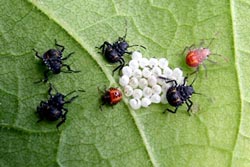
The brown marmorated stink bug has five nymphal stages, or instars, that range in size from less than 1/8 inch to 1/2 inch in length. Young nymphs are yellowish and mottled with black and red; older nymphs more closely resemble the adults.
Click on images to view full-size
Identification and Control Information
- Stop BMSB—USDA Special Crop Research Initiative
- Maine CAPS BMSB page—Maine Department of Agriculture, Conservation and Forestry
- Sucking Insects That Affect Vegetable Plants—University of Maine Cooperative Extension
- Regional Pest Alert: Brown Marmorated Stink Bug (PDF)—Northeastern IPM Center
- Fact Sheet: Brown Marmorated Stink Bug (PDF)—State of New Jersey, Rutgers Cooperative Extension
- Brown Marmorated Stink Bug—Massachusetts Introduced Pests Outreach Project
[Photos, left to right: Herb Pilcher, USDA Agricultural Research Service, Bugwood.org; Herb Pilcher, USDA Agricultural Research Service, Bugwood.org; David Cappaert, Michigan State University, Bugwood.org; Herb Pilcher, USDA Agricultural Research Service, Bugwood.org; Russ Ottens, University of Georgia, Bugwood.org; Russ Ottens, University of Georgia, Bugwood.org]
